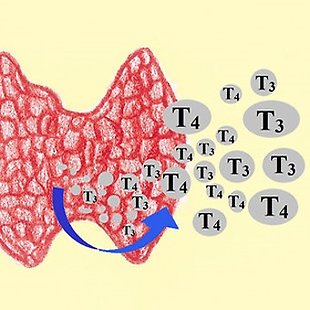Thyreotoxicosis
Clinical syndrome of thyrotoxicosis is the manifestation of tissue exposure to high levels of circulating thyroid hormones, which is accompanied by characteristic changes in their function. The most common form of thyrotoxicosis, which is caused by excessive thyroid gland, is hyperthyroidism. Shift from thyreotoxicosis of any type to a life-threatening state of a thyrotoxic crisis can caused by stress (emotional stress, intercurrent illness, surgery), destruction of functional tissue (radioiodine treatment), stable iodine (contrast medium administration) or abrupt withdrawal of thyrostatic agents. The failure of all compensatory mechanisms exacerbates the symptoms of toxicosis: agitation to delusional states, profuse sweating in hyperthermia, vomiting, diarrhea, hyperventilation, rhythm disorders and systolic dysfunction will accelerate the development of circulatory and metabolic failure. If treatment is not promptly initiated, mortality is high.
This algorithm will guide you through the issue of thyreotoxicosis with a focus on its diagnosis and treatment.
Review
Tyreotoxicosis is a clinical and biochemical condition caused by overproduction and the action of circulating thyroid hormones. This teaching material is not only about thyrotoxicosis in its own sense, but also points to the basic principles of treating a rare thyrotoxic crisis characterized by a severe or exacerbated clinical manifestation of hyperthyroidism. Gradually, a clinical picture is presented, with emphasis on dominant cardiac symptomatology, diagnosis, acute management of the patient, and, last but not least, definitive treatment of the disease. Consideration is given to availability in the treatment of recommended formulations in our conditions, and the pharmacological effects on the basis of which the particular drug is preferred. By studying the algorithm you can obtain the most important information about thyrotoxicosis and its most frequent cause.
Sources
SOUČEK, Miroslav. Vnitřní lékařství. 1. ed. Praha: Grada Publishing, 2011. ISBN 978-80-247-2110-1.
KLENER, Pavel. Vnitřní lékařství. 2., dopl. vyd. Praha: Galén, 2001. ISBN 80-7262-101-7.
GANONG, William F. Přehled lékařské fyziologie. 20. ed. Praha: Galén, 2005. xx, 890. ISBN 8072623117
ŠEVČÍK, Pavel. Intenzivní medicína. 3. ed. Praha : Galén, 2014. 1196 p. ISBN 978-80-7492-066-0
SILBERNAGL, Stefan and Agamemnon DESPOPOULOS. Atlas fyziologie člověka. 6. ed., Praha: Grada, 2004. xiii, 435. ISBN 802470630X.
SMITH, Terry J.and HEGEDUS, Laszlo. Graves’ Disease. N Engl J Med. 2016;375:1552-65. DOI: 10.1056/NEJMra1510030
ALLMAN, Keith G. and WILSON, Iain H., eds. Oxford Handbook of Anaesthesia. 3. ed. Oxford: Oxford University Press, 2011. 1309 p. ISBN 9780199584048
Zvýšená činnost štítné žlázy – tyreotoxikóza (hypertyreóza) [online]. 2011 [cit. 2017-05-31]. Retrieved from: http://endokrinologie-obezitologie.cz/cs/clanky/tema1/zvysena-cinnost-stitne-zlazy-tyreotoxikoza-hypertyreoza/
Diagnostika a terapie poruch funkce štítné žlázy - část II. [online]. Medicína pro praxi, 2008; 5(9): 315–321. [cit. 2017-05-31]. Retrieved from: https://www.medicinapropraxi.cz/pdfs/med/2008/09/09.pdf
Hypertyreóza z pohledu klinika. [online]. Interní medicína, 2014; 16(6): 232–235 [cit. 2017-05-31]. Retrieved from: https://www.internimedicina.cz/pdfs/int/2014/06/04.pdf
Tyreotoxikóza. [online]. 2003 [cit. 2017-03-15]. Retrieved from: http://zdravi.euro.cz/clanek/postgradualni-medicina/tyreotoxikoza-153007
Imunochemická diagnostika štítné žlázy [online]. 1997 [cit. 2017-03-15]. Retrieved from: http://oldweb.lfp.cuni.cz/journals/imj/1997/2/c22.html





